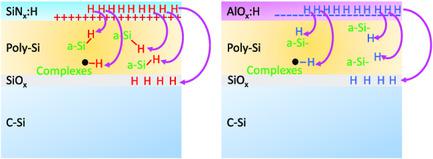Our official English website, www.x-mol.net, welcomes your
feedback! (Note: you will need to create a separate account there.)
Hydrogenation Mechanisms of Poly‐Si/SiOx Passivating Contacts by Different Capping Layers
Solar RRL ( IF 6.0 ) Pub Date : 2019-11-26 , DOI: 10.1002/solr.201900476 Thien N. Truong 1 , Di Yan 1 , Wenhao Chen 1, 2 , Mike Tebyetekerwa 1 , Matthew Young 3 , Mowafak Al-Jassim 3 , Andres Cuevas 1 , Daniel Macdonald 1 , Hieu T. Nguyen 1
Solar RRL ( IF 6.0 ) Pub Date : 2019-11-26 , DOI: 10.1002/solr.201900476 Thien N. Truong 1 , Di Yan 1 , Wenhao Chen 1, 2 , Mike Tebyetekerwa 1 , Matthew Young 3 , Mowafak Al-Jassim 3 , Andres Cuevas 1 , Daniel Macdonald 1 , Hieu T. Nguyen 1
Affiliation

|
Herein, posttreatment techniques of phosphorus‐doped poly‐Si/SiOx passivating contacts, including forming gas annealing (FGA), atomic layer deposition (ALD) of hydrogenated aluminum oxide (AlOx:H), and plasma‐enhanced chemical vapor deposition (PECVD) of hydrogenated silicon nitride (SiNx:H), are investigated and compared in terms of their application to silicon solar cells. A simple FGA posttreatment produces a significant increase in the implied open circuit voltage (iVoc) and the effective minority‐carrier lifetime (τeff) of high‐resistivity crystalline Si (c‐Si) samples, whereas low‐resistivity samples show a minimal change. Treatment by means of AlOx:H and/or SiNx:H followed by postdeposition FGA results in a universal increase in τeff and iVoc for all substrate resistivities (as high as 12.5 ms and 728 mV for 100 Ω cm and 5.4 ms and 727 mV for 2 Ω cm n‐type c‐Si substrates). In addition, both the FGA and AlOx:H + FGA techniques can inject sufficient hydrogen into the samples to passivate defects at the SiOx/c‐Si and poly‐Si/SiOx interfaces. However, this hydrogen concentration is insufficient to neutralize both the nonradiative defects inside the poly‐Si films and dangling bonds associated with the amorphous Si phase present in them. The hydrogen injected by the SiNx:H + FGA technique can passivate both the interfaces and the defects and dangling bonds within the poly‐Si film. These results are confirmed by low‐temperature photoluminescence spectroscopy, Fourier transform infrared spectroscopy, and dynamic secondary‐ion mass spectrometry measurements.
中文翻译:

不同封盖层对多晶硅/ SiOx钝化触点的加氢机理
本文介绍了磷掺杂的多晶硅/ SiO x钝化接触的后处理技术,包括形成气体退火(FGA),氢化氧化铝的原子层沉积(ALD)(AlO x:H)和等离子体增强化学气相沉积(研究了氢化氮化硅(SiN x:H)的PECVD),并比较了它们在硅太阳能电池中的应用。一个简单的FGA后处理产生的隐含的开路电压(IV一显著增加OC)和有效少数载流子寿命(τ EFF高电阻结晶Si(C-Si)的样本),而低电阻率的样品显示出最小改变。通过AlO x:H和/或SiN进行处理X:H,随后沉积后FGA导致在一个普遍增加τ EFF和N- OC所有衬底的电阻率(高达12.5毫秒和728毫伏100Ω厘米和5.4毫秒和727毫伏2Ω厘米n型C-硅基板)。此外,FGA和AlO x:H + FGA技术都可以向样品中注入足够的氢,以钝化SiO x / c-Si和poly-Si / SiO x界面处的缺陷。但是,这种氢浓度不足以抵消多晶硅膜内部的非辐射缺陷和与其中存在的非晶硅相相关的悬空键。SiN x注入的氢:H + FGA技术可以钝化多晶硅膜中的界面以及缺陷和悬空键。低温光致发光光谱法,傅立叶变换红外光谱法和动态二次离子质谱法测量结果证实了这些结果。
更新日期:2019-11-26
中文翻译:

不同封盖层对多晶硅/ SiOx钝化触点的加氢机理
本文介绍了磷掺杂的多晶硅/ SiO x钝化接触的后处理技术,包括形成气体退火(FGA),氢化氧化铝的原子层沉积(ALD)(AlO x:H)和等离子体增强化学气相沉积(研究了氢化氮化硅(SiN x:H)的PECVD),并比较了它们在硅太阳能电池中的应用。一个简单的FGA后处理产生的隐含的开路电压(IV一显著增加OC)和有效少数载流子寿命(τ EFF高电阻结晶Si(C-Si)的样本),而低电阻率的样品显示出最小改变。通过AlO x:H和/或SiN进行处理X:H,随后沉积后FGA导致在一个普遍增加τ EFF和N- OC所有衬底的电阻率(高达12.5毫秒和728毫伏100Ω厘米和5.4毫秒和727毫伏2Ω厘米n型C-硅基板)。此外,FGA和AlO x:H + FGA技术都可以向样品中注入足够的氢,以钝化SiO x / c-Si和poly-Si / SiO x界面处的缺陷。但是,这种氢浓度不足以抵消多晶硅膜内部的非辐射缺陷和与其中存在的非晶硅相相关的悬空键。SiN x注入的氢:H + FGA技术可以钝化多晶硅膜中的界面以及缺陷和悬空键。低温光致发光光谱法,傅立叶变换红外光谱法和动态二次离子质谱法测量结果证实了这些结果。











































 京公网安备 11010802027423号
京公网安备 11010802027423号